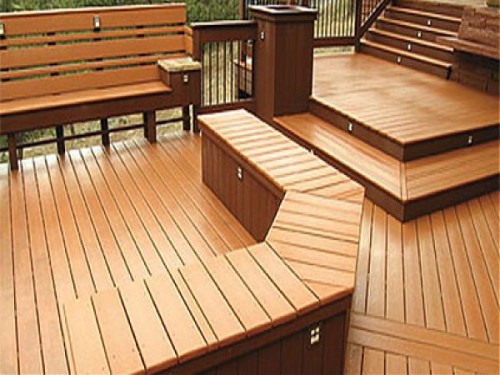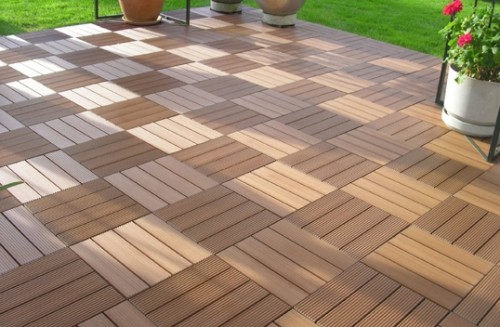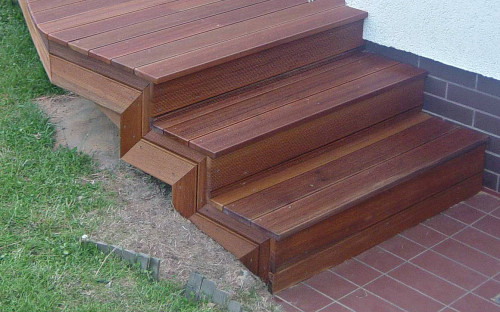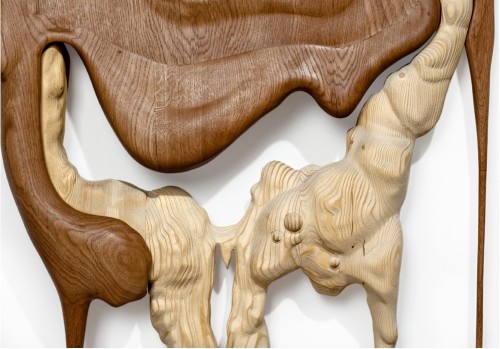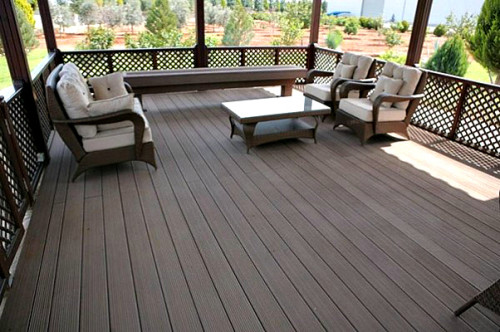
Liquid tree - new building material Building materials
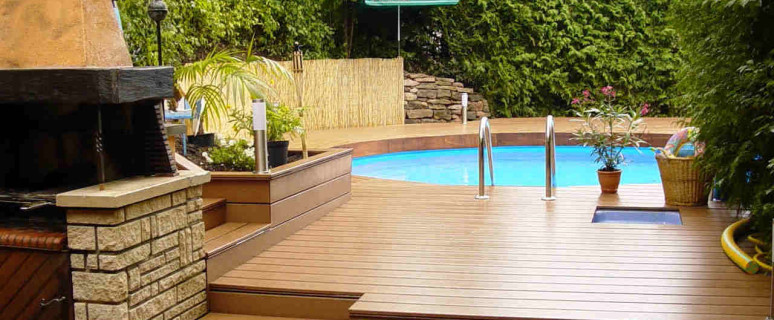
Following the liquid wallpaper and bulk floors, a liquid tree appeared - a composite, well replacing the designs of wood. Created this new building material from waste in Germany, and now it finds more and more of his fans in our market. What is a liquid tree, where and how it is used - our article will tell about it.
Content
What makes it
This material consists of such ingredients:
- Wood chopped filler, which is waste woodworking. His percentage of DPK ranges from 40 to 80%.
- Artificial thermoplastic polymers such as polyethylene, polypropylene, polyvinyl chloride. They bind particles of filler into a single mass.
- Additives (additives) in the form:
- lubricators that increase moisture resistance;
- modifiers that give the material increased strength and facilitate better conservation of the form;
- kolorantov used to give boards from a liquid wood of paints, evenly distributed over the surface, saturated and persistent;
- foaming agents making the surface of the ideal and reduction weight of the final product;
- biocides protecting liquid wood from fungus, mold and boring.
It makes it on the appropriate equipment according to the following technology:
- mix all components;
- heated to a liquid state;
- subjected to joint polymerization;
- poured a hot mixture under pressure in special forms;
- cool.
As a result, the anteroplast has better characteristics and polymer, and wood, where texture, color, environmental safety and even smell, identical to wood.
The advantages and weaknesses of the wood-polymer composite
Like any building material, the DPK has advantages and weaknesses.
Advantages of DPK.
Compared to a natural tree, its liquid analogue has several advantages:
- moisture resistance several times higher;
- adaptation to temperature drops. Does not lose properties in the range from -50 to +150 degrees C;
- mechanical damage resistance is very high;
- resistance to the effects of insects, damaging wood, mold formation, due to the presence of antimicrobial additives in its composition;
- easy processing and installation. Suitable the same tools as for wood;
- easy to care. Opened operations such as painting, varnishing, cycle;
- durability. Even the floor of a liquid tree will serve, the smallest, 25 years;
- resistance to aggressive chemicals;
- the ability to take any desired form;
- accountability - DPDs are recycled again;
- variety of colors and shades;
- efficiency - the material is cheaper than expensive natural wood, and characteristics are identical.
Disadvantages of DPK.
To the disadvantages of theldasts include:
- The undesirableness of its use in places where high temperature and increased humidity prevail simultaneously.
- The presence of special ventilation requirements.
Liquid wood products
From the DPK do:
- Parquet garden in the form of a 2-layer tile 300x300 mm. Its thickness from 20 to 50 mm. The first layer is a plastic substrate, and the 2nd - dug from DPK attached to the substrate with screws. To the ground, this parquet is not attached, they simply resist a seating area in summer.
- Siding, which is finished at home outside.
- The terrace board, which is also called Decing. It is satisfied with the floors of both in the house and in open balconies, terraces. She is overlooked pier, poults, ship decks, car parking. The configuration of this profile product occurs the most different. In addition, Decing happens:
- hollow used mainly in everyday life;
- solid, styling of which implies the effect on it of large loads;
- corrugated and smooth.
How to choose a DPK
To buy a liquid tree, you should know what features to make a choice, otherwise you will acquire poor-quality material. So what to see:
- If brighter particles are clearly visible on the product, it means that it was used here a poorly sprinkling wood flour. The water resistance of such a DPK is reduced. During precipitation, water will accumulate here, which will gradually destroy the board.
- When you choose a product from a liquid tree, then pay attention not only to its decorative properties, but also on the texture. For example, the surface polished is very slippery, it means that it is hardly relevant for the floor.
- The quality of the wood-polymer composite also says his color. If in the manufacture of a liquid mass well mixed, then on the surface of the finished product, you will see transitions, divorces, in general, inhomogeneous color. Combating manufacturers are usually not allowed.
- A high-quality liquid tree is obtained only when shelled wood waste was used to prepare wood flour. Using coniferous trees as a wood filler, the manufacturer gets unstable, and even a very fire-hazardous mixture.
It follows the conclusion that buying composite wood, you should choose authoritative manufacturers. High quality is distinguished by a full-scale terrace board from the American trademark TREX. It is characterized by:
- high wear resistance;
- beautiful design;
- manufacturer's warranty for 25 years.
Destinations and parquet Decing from LG (South Korea). Liquid wood, the price and quality of which corresponds to the category Best, is different:
- a special profile providing high strength;
- the presence of a mixture of polymers who gave it the best properties;
- the texture repeating the structure of the tree;
- bilateral unique surface;
- fashionable modern flowers.
The unique properties have both DPK Twinson (Twinson), which is produced by the International Concern Deceuninck Group:
- he is moisture-resistant;
- visually indistinguishable from natural wood;
- withstands heavy loads;
- resistant to cracking and warping;
- does not change color;
- non-slip.
But the liquid tree is not only the boards, there is also a liquid paint tree. About him a conversation separate.
Kaowa Sementol
Kaowa Sementol's paint, Kaowa Sementol (Kaza Sementol) paint from the Spanish manufacturer Paigum mimics the texture of elite wood. Apply it both inside and outside. Used:
- for staining of furniture;
- coatings of doors and windows of white plastic;
- household appliances;
- products made of drywall, metal, fiberboard, chipboard, wood, even if they have already been painted with another paint or covered with enamel.
The technical characteristics of it are as follows:
- dries in 2 hours;
- applied with a brush;
- it is consumed at the rate of 0.1 liters per quarter. m.
Recommendations for applying paint Liquid tree with their own hands
In order for the surface after the finish, it is necessary to comply with some recommendations:
- We prepare the surface, while if it is porous, the basis is applied. Polished surface is treated with sandpaper.
- Mix the contents of the jar by shaking. We do not use any solvents and dyes.
- Apply the paint with a thick layer in one direction, but so that no ilk is observed.
- Moving horizontally, distribute uniformly applied paint, without wasting an additionally brush. Within 15 minutes, the surface can also be corrected, and then it dries.
- We cover the surface after it drying with varnish, in case it is subjected to atmospheric influences.
Installation of liquid wood boards with their own hands
The durability of the parquet or terraced board is affected not only the initial quality, but also the correctness of its installation. Technology is simple and accessible to everyone:
- Install lagows.
- Confirm to the supporting beams board so:
- in the groove at an angle of 45 degrees, screw in the self;
- install the clip;
- we strengthen additional clips using self-pressing;
- i mount the next board, for which its grooves insert into the clips;
- by installing all the boards, mount overhead planks on the ends.
Make a liquid tree with your own hands
Sometimes there is a need to repair furniture from chipboard, for example, a canopy escaped with the roots of laminate, parquet board. It would be nice to close the hole with a liquid tree, but where to take it? It turns out that it is not difficult to make an analog of DPK. To do this, we reserve:
- pva glue;
- sawdust.
Next proceed directly to the manufacture:
- grind sawdust to dust state. It turns out well in the coffee grinder;
- mix with glue to make a pasty consistency;
- we select the desired color by adding a dye to the paste, which is usually used for water-level paint;
- close up a damaged place, we wait until it dries and grind the fine-grained emery.




